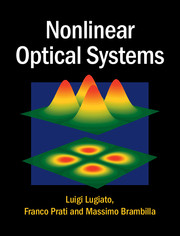Book contents
- Frontmatter
- Dedication
- Contents
- Preface
- Part I Models, propagation, stationary phenomena
- 1 The rate-equation model for the laser
- 2 The interaction of a system of two-level atoms with the electromagnetic field
- 3 The Maxwell–Bloch equations
- 4 Inclusion of the irreversible processes in the atomic equations
- 5 Propagation in irreversible Maxwell–Bloch equations
- 6 Optical nonlinearities. Materials with quadratic nonlinearities
- 7 Optical nonlinearities. Materials with cubic nonlinearities
- 8 Optical resonators. The planar ring cavity. Empty cavity. Linear cavity
- 9 A nonlinear active ring cavity: the ring laser, stationary states
- 10 The adiabatic elimination principle
- 11 A nonlinear passive ring cavity: optical bistability
- 12 Modal equations for the ring cavity. The single-mode model
- 13 Single- and two-mode models
- 14 Nonlinear dynamics in Fabry–Perot cavities
- 15 Inhomogeneous broadening
- 16 The semiconductor laser
- 17 Lasers without inversion and the effects of atomic coherence
- Part II Dynamical Phenomena, Instabilities, Chaos
- Part III Transverse optical patterns
- Appendix A The Routh–Hurwitz stability criterion
- Appendix B Calculation of the oscillatory instability boundary
- Appendix C Coefficients of the characteristic equation (20.20)
- Appendix D Derivation of equations (20.27) and (20.28)
- Appendix E Coefficients of equations (20.60) and (20.61)
- Appendix F The exact boundary of the Risken–Nummedal–Graham–Haken instability
- Appendix G Nonlinear analysis of the roll solution
- References
- Index
15 - Inhomogeneous broadening
from Part I - Models, propagation, stationary phenomena
Published online by Cambridge University Press: 05 March 2015
- Frontmatter
- Dedication
- Contents
- Preface
- Part I Models, propagation, stationary phenomena
- 1 The rate-equation model for the laser
- 2 The interaction of a system of two-level atoms with the electromagnetic field
- 3 The Maxwell–Bloch equations
- 4 Inclusion of the irreversible processes in the atomic equations
- 5 Propagation in irreversible Maxwell–Bloch equations
- 6 Optical nonlinearities. Materials with quadratic nonlinearities
- 7 Optical nonlinearities. Materials with cubic nonlinearities
- 8 Optical resonators. The planar ring cavity. Empty cavity. Linear cavity
- 9 A nonlinear active ring cavity: the ring laser, stationary states
- 10 The adiabatic elimination principle
- 11 A nonlinear passive ring cavity: optical bistability
- 12 Modal equations for the ring cavity. The single-mode model
- 13 Single- and two-mode models
- 14 Nonlinear dynamics in Fabry–Perot cavities
- 15 Inhomogeneous broadening
- 16 The semiconductor laser
- 17 Lasers without inversion and the effects of atomic coherence
- Part II Dynamical Phenomena, Instabilities, Chaos
- Part III Transverse optical patterns
- Appendix A The Routh–Hurwitz stability criterion
- Appendix B Calculation of the oscillatory instability boundary
- Appendix C Coefficients of the characteristic equation (20.20)
- Appendix D Derivation of equations (20.27) and (20.28)
- Appendix E Coefficients of equations (20.60) and (20.61)
- Appendix F The exact boundary of the Risken–Nummedal–Graham–Haken instability
- Appendix G Nonlinear analysis of the roll solution
- References
- Index
Summary
Up to this point we have always assumed that all the atoms which interact with the radiation field have the same atomic transition frequency, with an atomic linewidth given by γ⊥. This configuration is called homogeneous broadening. However, in the great majority of lasers the linewidth is inhomogeneously broadened, because the atomic frequency follows a distribution. For example, in solid-state lasers such as the ruby laser and fiber lasers the inhomogeneity is due to the imperfections in the crystalline structure of the material. In gas lasers, where the atoms or molecules are free to move, the inhomogeneous broadening is due to the Doppler effect, for which a molecule moving with velocity v in a field of frequency ω and wave vector k experiences an effective frequency ω′ = ω − k · v [8]. Since what matters is the difference between the atomic transition frequency and the field frequency, we can keep the field frequency fixed and imagine that the field interacts with different groups of atoms that move with different velocities and therefore have different transition frequencies. The realistic velocity distribution is a Gaussian, for which the corresponding distribution for the modulus of the velocity is Maxwellian. However, in the following we will mainly analyze the case of a Lorentzian distribution for the atomic transition frequency, because this allows an analytical treatment.
Again for the sake of simplicity, we will limit our analysis to the case of a ring cavity. In Section 15.1 we will generalize to the inhomogeneous-broadening configuration the modal equations for the case of homogeneous broadening, which were formulated in Chapter 12. In Section 15.2 we will specialize to the single-mode model and discuss its stationary solutions for the laser case.
Multimode dynamical equations
The atomic transition frequency of the generic group of atoms is given by ωa + δD, where ωa is the central atomic frequency and δD takes positive and negative values. We call ωc the frequency of the cavity mode nearest to ωa and denote by δac the difference ωa − ωc.
- Type
- Chapter
- Information
- Nonlinear Optical Systems , pp. 170 - 176Publisher: Cambridge University PressPrint publication year: 2015



